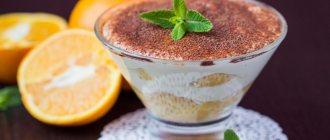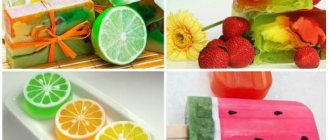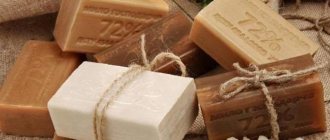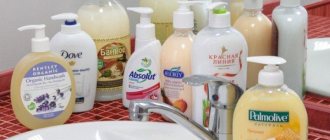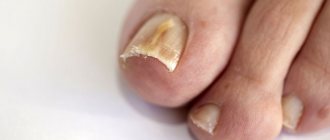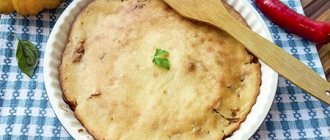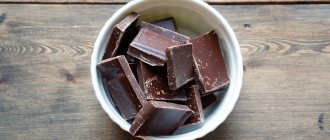Soap is traditionally made by treating plant and animal fats with alkaline compounds. In addition to solid varieties, among which the most common are household and toilet soap, there is liquid, or bulk, soap. Industrial methods for making liquid soap, as well as solid soap, involve the use of complex technologies and precise dosages of ingredients; handmade soap can be made by anyone from easily accessible and inexpensive components without special equipment or training.
Benefits of handmade liquid soap
Cheap, industrially produced liquid soap usually has a strong smell and beautiful packaging. By and large, this is a household detergent obtained by appropriate processing of waste from the petrochemical industry, low-quality fats, oils and acids. When using such products, various skin health problems are possible: from dryness and itching to exfoliation of dermis particles and severe allergic reactions.
Properly prepared handmade liquid soap cannot be compared with factory-made ones. Of course, manufacturers who care about their reputation and consumer health produce many varieties of products with natural oils, herbal decoctions, honey, propolis, egg yolk, juices, etc. But in any case, even the highest quality soap contains from ten to twenty percent of chemicals in its composition, but it has a pleasant smell and attractive appearance (including packaging). Despite this, a homemade product can also look beautiful and have a stunning aroma, but be one hundred percent natural.
Eco-friendly handmade soap without the use of a base (unless dyes and chemical fragrances are added to it) does not contain synthetic components such as:
- surfactants,
- preservatives,
- silicone,
- plasticizers.
Making handmade liquid soap also involves the use of various oils, among which the most commonly used are:
- olive,
- coconut,
- cocoa,
- shi,
- almond,
- grape (from grape seeds),
- wheat germ.
All of the above components have certain advantages and disadvantages and are often selected individually in the process of home soap making.
Thus, olive oil is used to rejuvenate the skin, increase its tone, relieve inflammation and control fluid balance. Coconut oil protects the skin from the harmful effects of sunlight and other unsafe environmental factors. Cocoa is ideal for relieving symptoms of skin fatigue. Shea butter is suitable for moisturizing and nourishing dry dermis. Almond product serves to relieve dryness and restore skin particles. Grapeseed oil reduces skin oiliness and is absorbed very quickly. And finally, a wheat germ product is a powerful fortified additional remedy against skin aging, raising tone and improving blood flow.
How to make soap with your own hands
Do-it-yourself liquid soap, depending on the ingredients, can be expensive, but it will be a truly environmentally friendly, healthy product. In addition, homemade soap making will also bring creative satisfaction.
Next, we will look at several options for making liquid soap with your own hands, including:
- From a bar of solid soap.
- From remnants.
- No cooking.
- Liquid soap based.
Needless to say again, homemade soap will certainly be healthier than store-bought soap, and thanks to the opportunity to experiment, you can achieve amazing aromas and colors of your handmade product.
Cooking from a bar of solid soap
According to reviews from people involved in home soap making, baby soap is most suitable as a raw material for the base. In principle, this is an optional condition; the component is completely replaceable with any product with a neutral composition.
What ingredients will be needed:
- a bar of baby soap,
- two teaspoons of glycerin,
- any essential oil.
And:
- a little honey
- herbal infusion,
- essential oils,
- natural dyes.
How to cook:
1. Grate the soap on a fine grater.
2. Pour four cups of boiling water over the grated soap.
3. Stir the mixture to a uniform consistency.
4. Wait a little (the liquid should cool completely) and add glycerin.
5. Now you can add six to ten drops of essential oil, such as lemon, to the mixture, add two teaspoons of honey, which softens the skin well, and dilute the almost finished liquid soap with cold water (about seven to eight glasses) to the required thickness and to stir thoroughly.
6. Pour the finished product into a bottle with a dispenser.
If you wish, you can add a little coffee to the prepared liquid soap; this will give the mixture an unusual aroma and a beautiful shade, and will also help exfoliate the skin when washing.
Liquid soap made from soap
Making liquid soap from soap remnants is not difficult, but the process takes quite a long time.
What ingredients will be needed:
- two hundred grams of soap,
- half a glass of hot water,
- three tablespoons of glycerin,
- one teaspoon of lemon juice.
Crumble the soap as finely as possible. Pour the finished raw material into a suitable container and fill it with very hot water, then add glycerin and add a little lemon juice. Mix the contents of the dish thoroughly and leave for three days. Shake the container periodically (two to three times a day). After the specified period has expired, pour the liquid into a bottle with a dispenser. Instead of lemon juice, you can use other ingredients.
Simple recipe without cooking
To make homemade liquid soap without cooking, you need a certain amount of ingredients and patience.
What you will need:
- bar of baby soap,
- two liters of water (can be replaced with herbal decoction),
- two tablespoons of glycerin,
- food colorings,
- natural flavors,
- essential oils.
A fine grater will help you turn solid soap into shavings. The resulting raw material must be poured into warm water (decoction), mixed thoroughly and left for 24 hours. After the mixture becomes completely homogeneous, add glycerin and additional components to it. Mix everything and pour into a bottle with a dispenser.
Liquid soap based
Making liquid soap with your own hands using a ready-made base is even easier.
Lemon
What you will need:
- two hundred milliliters of liquid soap base from any manufacturer,
- six milliliters of jojoba oil,
- one teaspoon of honey,
- five drops of any essential oil,
- seven drops of lemon oil,
- any natural dye.
Place the soap base in a suitable container, add honey and jojoba oil. Mix thoroughly until smooth. Add essential oils and mix again. Leave the mixture for one hour, then pour the finished liquid soap into a bottle with a dispenser.
Liquid soap-scrub
What ingredients will be needed:
- two hundred milliliters of liquid soap base from any manufacturer,
- five milliliters of avocado oil,
- three teaspoons of blue clay,
- ten drops of grapefruit essential oil.
In a suitable size container, mix liquid soap base and three teaspoons of blue clay. Add avocado oil and essential oil. Stir and pour into a bottle with a dispenser. The soap is ready for use.
Children's
Liquid baby soap is a hypoallergenic and anti-inflammatory product; it soothes and moisturizes the delicate skin of a child.
What is necessary:
- two hundred milliliters of liquid soap base from any manufacturer,
- five milliliters of jojoba oil
- six teaspoons of chamomile infusion,
- six drops of fragrance (optional),
- crushed dried chamomile flowers if desired.
Combine the base with the decoction. Mix thoroughly and add jojoba oil. Pour in the crushed dry chamomile flowers and mix again, then add the fragrance. Pour the finished product into the dispenser.
Video: a simple recipe for making homemade liquid soap
All natural soap
To be completely confident in the quality of your soap, it is best to prepare it yourself using natural ingredients :
- 100 g soap base;
- 2 liters of water;
- 1 tablespoon each of coconut, olive and shea butter.
It is prepared in the same way as other types of liquid soap:
- A special soap base is grated.
- The water is brought to a boil and the resulting shavings are carefully added to it, which are stirred until completely dissolved.
- Then add the prepared oil mixture. Everything is mixed well and used as intended.
What additional ingredients can you use?
Among the additional components of liquid soap, first of all, we can note:
- Nourishing oils.
- Fillers.
- Essential oils.
- Fragrances and flavors.
Table: additional components of liquid soap
| Nourishing oils | They can be either liquid or solid. Among the latter, the most popular among soap makers are cocoa, coconut, palm, shea and mango oils. There are a lot of varieties of liquid oils, and most of them have found their application in soap making, including oils from olives, almond and grape seeds, walnuts, sea buckthorn and jojoba. All these substances are extremely useful due to the content of vitamin and acid complexes in their composition; they are characterized by high levels of nutrition and skin protection, but are usually selected based on individual preferences. | During the soap-making process, you should not overuse oils; an excess of the latter can have a bad effect on the appearance and quality of liquid soap. |
| Fillers | The presence or absence of fillers in a recipe often depends on the intended end result. Liquid soap fillers can include liquid honey, aloe vera gel, glycerin, liquid vitamin complexes, flowers and herbs, infusions, cosmetic clay, sea salt, oatmeal, bran, cocoa and coffee, sugar, lemon or orange zest, coconut flakes. and much more. | To enhance the visual effect, it is permissible to introduce any decorations and toys into liquid soap. |
| Essential oils | The component gives the soap a unique aroma, plus it provides therapeutic and therapeutic functions. Tea tree oil, for example, is a powerful antiseptic and has a beneficial effect on oily skin, chamomile essential oil is suitable for babies, and lavender is useful for stress. | The use of essential oils in any recipe requires attention and depends on the individual characteristics of the person. Some substances in high concentrations can cause allergies. |
| Fragrances and flavors | Optional components that give liquid soap a distinctive smell. The scope and variations in the use of these substances depend on your desires and flights of fancy. Moreover, adequate joint use of both is acceptable. | Fragrances and flavors can be either chemical or natural, and here again the choice is yours. |
Making liquid soap with your own hands, like any other creative process, should be fun. To avoid mistakes that can ruin your mood, the author of the article recommends paying attention to the following points:
- think through everything in advance (including the sequence of actions), ingredients and equipment should always be at hand during the soap making process,
- do not overheat the base and under no circumstances bring it to a boil, this will cause a significant deterioration in its properties,
- When working with heat, use utensils with handles,
- the block rubs easier when slightly heated,
- maintain moderation with the amount of oils, this applies to both main and additional essential products,
- maintain moderation with the amount of abrasives, unless you need a super-hard scrub,
- do not add water to the soap base, at best it will not provide any benefits, at worst you will ruin the ingredient,
- put only dried flowers and herbs into liquid soap, fresh plant parts will cause the product to become moldy over time,
- maintain moderation with the amount of fragrances and fragrances, use natural ingredients whenever possible,
- Pre-dissolve dye powders in water or oil,
- don’t be afraid to experiment, this is the only way you can achieve a unique result.
Coffee soap-scrub
If, while preparing liquid soap, you add ground coffee to the scrubbing ingredients, for example, you will get a good homemade scrub.
It requires the following components:
- 50 g soap or base;
- 4 glasses of water;
- 0.5 cups cream;
- 2 spoons of sugar;
- 1 spoon of ground coffee (additionally you can add the same amount of cocoa powder);
- 0.5 tablespoons of glycerin or any essential oils;
- half an ampoule of vitamin A and E.
Prepare a homemade scrub like this:
- Grind the soap or base.
- Mix water with cream and put on fire.
- Add the shavings and stir until dissolved.
- Add sugar, coffee and cocoa to the mixture. Mix.
- After cooling, add vitamins A and E, oil or glycerin. Mix.
How to store the finished product
The shelf life of handmade liquid soap depends on the ingredients used and some other conditions. The presence of preservatives in its composition increases the shelf life; direct sunlight, on the contrary, reduces the storage time. It is not recommended to keep the product open. Do-it-yourself liquid soap is best stored in a cool, dry place; the ambient temperature should not exceed ten degrees Celsius.

